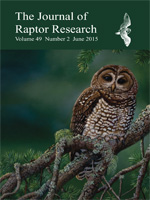We used radiotelemetry to study space use and habitat selection of 16 Northern Spotted Owls (Strix occidentalis caurina) on the eastern slope of the Cascade Mountains, Washington, U.S.A., in 1989–1990. We used a geographical information system (GIS) and aerial photo interpretation of digital orthophotos to assign owl locations a value for vegetation type, topographic position, amount of edge, and distance to water. We compared owl relocations and random locations within 95% fixed kernel (FK) home ranges to determine each owl's selection of cover types, using logistic regression and generalized estimating equations (GEE) to estimate an exponential resource selection function likelihood. Minimum convex polygon (MCP) home ranges (SE) averaged 2858 ha (712 ha) for males and 1883 ha (249 ha) for females. Individual 95% FK home ranges averaged 1980 ha (229 ha) for males and 1649 ha (163 ha) for females. Pair home ranges averaged 3419 ha (826 ha) for MCP and 2427 ha (243 ha) for 95% FK. Nonbreeding season home ranges averaged approximately 3.5 times larger than breeding season home ranges for both males and females. Our best habitat model indicated that owls selected closed-canopy forests with a component of large (≥50 cm dbh) trees for roosting and foraging. In a given cover type, owls foraged lower on the slope. Management circles centered on nest areas—commonly used as a surrogate for home ranges—can be relatively poor representations of actual ranges used by pairs. However, an alternative for managing Spotted Owl home ranges is not readily available. Maintaining sufficient closed-canopy forest to provide habitat for Spotted Owls in the dry, fire-prone forests on the eastern slope of the Washington Cascades will be a challenge because forestry methods used to reduce the risk or severity of fire generally reduce the prevalence of structural features that characterize good Spotted Owl habitat.
How to translate text using browser tools
1 June 2015
Home Range and Habitat Selection by Northern Spotted Owls on the Eastern Slope of the Cascade Mountains, Washington
Eric D. Forsman

Journal of Raptor Research
Vol. 49 • No. 2
June 2015
Vol. 49 • No. 2
June 2015
fixed kernel
habitat selection
home range
minimum convex polygon
Northern Spotted Owl
radiotelemetry
Strix occidentalis caurina




